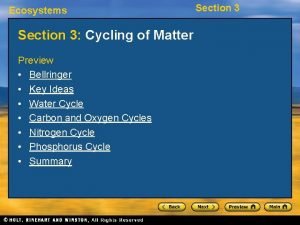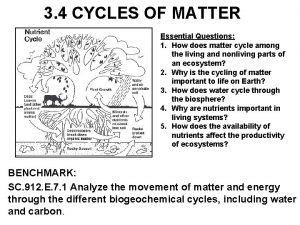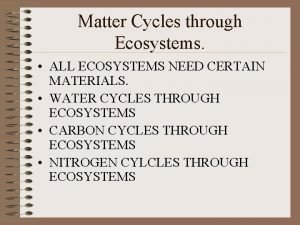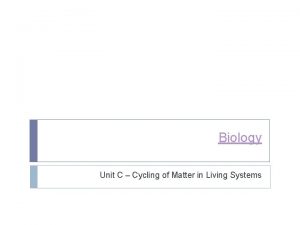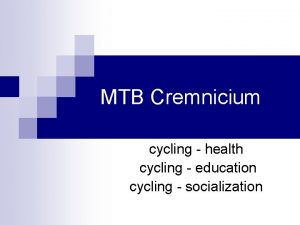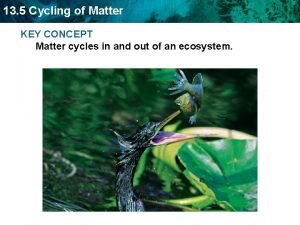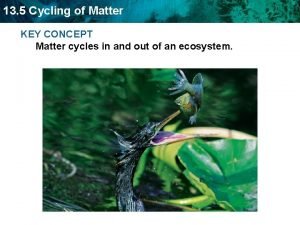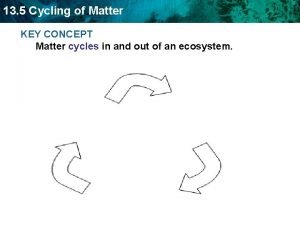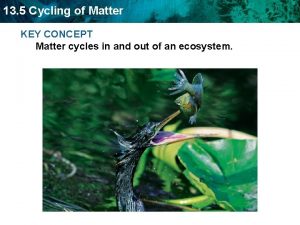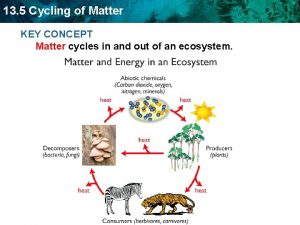13 5 Cycling of Matter KEY CONCEPT Matter









- Slides: 9

13. 5 Cycling of Matter KEY CONCEPT Matter cycles in and out of an ecosystem.

13. 5 Cycling of Matter Water cycles through the environment. • The hydrologic, or water, cycle is the circular pathway of water on Earth. • Organisms all have bodies made mostly of water. precipitation condensation transpiration lake surface runoff evaporation water storage in ocean groundwater see pag e

13. 5 Cycling of Matter Elements essential for life also cycle through ecosystems. • A biogeochemical cycle is the movement of a particular chemical through the biological and geological parts of an ecosystem. • The main processes involved in the oxygen cycle are photosynthesis and respiration.

13. 5 Cycling of Matter • Oxygen cycles indirectly through an ecosystem by the cycling of other nutrients. oxygen photosynthesis Fig. In the oxygen cycle, oxygen flows into the atmosphere as a byproduct of photosynthesis. Organisms take in this oxygen and release it as carbon dioxide through respiration carbon dioxide

13. 5 Cycling of Matter • Carbon is the building block of life. – The carbon cycle moves carbon from the atmosphere, through the food web, and returns to the atmosphere. – Carbon is emitted by the burning of fossil fuels. – Some carbon is stored for long periods of time in areas called carbon sinks. carbon dioxide in air combustion respiration photosynthesis Fig. Photosynthesis and respiration account for much of the transformation and movement of carbon. respiration decomposition of organisms fossil fuels photosynthesis carbon dioxide dissolved in water

13. 5 Cycling of Matter • The nitrogen cycle mostly takes place underground. – Some bacteria convert gaseous nitrogen into ammonia through a process called nitrogen fixation. – Some nitrogen-fixing bacteria live in nodules on the nitrogen in roots of legumes; atmosphere animals others live freely in the soil. plant Fig. Much of the nitrogen cycle occurs underground, where bacteria transform ammonium into nitrates, which are used by plants to make amino acids. nitrogen-fixing bacteria in decomposers roots ammonification nitrogen-fixing ammonium bacteria in soil nitrifying bacteria nitrates nitrifying bacteria nitrites denitrifying bacteria

13. 5 Cycling of Matter – Ammonia released into the soil is transformed into ammonium. – Nitrifying bacteria change the ammonium into nitrate. – Nitrogen moves through the food web and returns nitrogen in atmosphere to the soil during animals decomposition. Fig. Much of the nitrogen cycle occurs underground, where bacteria transform ammonium into nitrates, which are used by plants to make amino acids. plant nitrogen-fixing bacteria in decomposers roots ammonification nitrogen-fixing ammonium bacteria in soil nitrifying bacteria nitrates nitrifying bacteria nitrites denitrifying bacteria

13. 5 Cycling of Matter Eutrophication When excessive inorganic nutrients (like nitrogen or phosphorus) build up in a lake or other body of water algal blooms occur. This is usually caused by excessive use of fertilizers that run off from land into the water system. Once the algae and plants die off, decomposers deplete the water of oxygen while breaking down the dead plant and algae matter. Once oxygen levels drop too low, fish and other animals that live in the water suffocate and die. Fig. Red tide is a phenomenon caused by algal blooms (Wikipedia definition) during which algae become so numerous that they discolor coastal waters (hence the name "red tide"). The algal bloom may also deplete oxygen in the waters and/or release toxins that may cause illness in humans and other animals. Jun 14, 2015

13. 5 Cycling of Matter • The phosphorus cycle takes place at and below ground level. – Phosphate is released by the weathering of rocks. – Phosphorus moves through the food web and returns to the soil during decomposition of organic matter. – Phosphorus leaches into groundwater from the soil and is locked in sediments. – Both mining and agriculture add phosphorus into the environment. rain plants geologic uplifting weathering of phosphate from rocks runoff animals phosphate in solution in soil leaching decomposers sedimentation forms new rocks
 Section 3 cycling of matter answer key
Section 3 cycling of matter answer key Chapter 2 section 1 organisms and their relationships
Chapter 2 section 1 organisms and their relationships 4 cycles of life
4 cycles of life Principles of ecology organisms and their relationships
Principles of ecology organisms and their relationships Matter cycling in ecosystems
Matter cycling in ecosystems Principles of ecology chapter 2 section 1 answer key
Principles of ecology chapter 2 section 1 answer key Cycling of matter definition biology
Cycling of matter definition biology Chapter 2 section 1 classifying matter answer key
Chapter 2 section 1 classifying matter answer key Chapter 4 lesson 4: metamorphic rocks answer key
Chapter 4 lesson 4: metamorphic rocks answer key Lesson 1 waves answer key
Lesson 1 waves answer key
